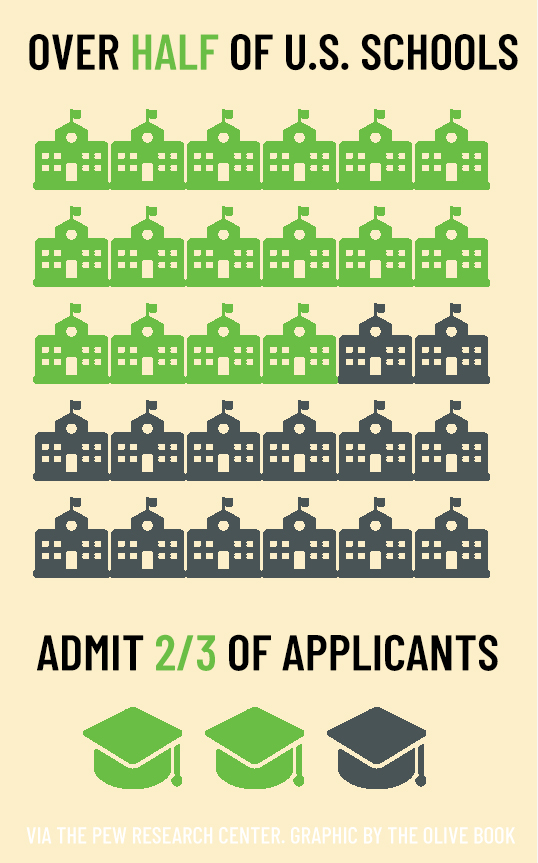Unless you’re lucky enough to qualify for automatic admission at your dream school, this question—how many colleges should you apply to—has probably been plaguing you since you first opened up the Common App. With over 3,000 universities in the United States alone, the options combined with the tendency to think that the more schools you apply to, the better, can be overwhelming.
So…How Many Colleges Should I Apply To?

Here’s the quick answer: we recommend you apply to about 8-9 schools that you are actually interested in attending. Of those 8-9 schools, 3 should be safety schools (your admissions test scores are above the 75th percentile for the college), 3 should be match schools (your scores are between the 25th and 75th percentiles for the college), and 2-3 should be reach schools (your scores are below the 25th percentile for the college).
That may be a smaller number than you thought; we’ve heard of students admitting they’ve applied to up to 30 schools, and the ease of the Common App and prevalence of university marketing has only made it easier and more popular to apply to as many schools as possible. And while it’s true that increasing the number of schools you apply to increases the number of schools you may get in to, it does not increase your chances of getting into each individual school.
That may seem obvious. But are you considering that factor when you make your list of schools to apply to? You have to think probabilistically here: what are your actual chances of getting into the schools you’re applying to? And more importantly, do you even like all the schools on your list?
Your Guide to the Common Application
How to Narrow Down Which Colleges To Apply To
Before you start applying to schools, take a few minutes to evaluate your scores and how they match up to the schools you want to apply to. Try sorting your schools into safety, match, and reach. Once you’ve done this, take a hard look at the schools and strike off the schools you wouldn’t attend, even if you got an offer. Keep an open mind during this process; if you haven’t visited the campus or met with any students, be extra careful not to evaluate a school on its reputation alone.
Sort your list of schools into safety, match, and reach. Take schools off the list that you wouldn’t attend, even if you got an offer. Finally, evaluate your list realistically; make sure your columns don’t have more “reach” schools than “match” or “safety” schools.
If you have the time and the means, visit as many schools on your list as you can in order to get a feel for different kinds of colleges. Even if you can only visit one school, you can learn a lot from the one school you visit. Take notes as you walk around the campus; how do you like the size of the school? What does a suburban campus really look like? If you’re interested in an urban school, have you spent any time in an urban environment? Is there green space (and is that important to you)? Do you like the dorms? What are the students like?
6 Things to Know Before Your College Campus Visit
Try and build an understanding of what the descriptors you read about colleges really feel like in real life. Even if you can’t visit any schools, do some research online. You can find so much information from current students about the dorms, food, and environment just from a little online digging.
The Top 10 Colleges in Your SAT Score Range
Apply to Schools You’d Attend
One of our course instructors, Cristina, grew up in a city in Texas and assumed she wanted to attend a college in an urban environment on the northern part of the east coast. She made the trip to Rhode Island, Massachusetts, New York, and DC to tour her top schools–and was shocked when she did not like them. When she toured Trinity University in Texas and loved it, she realized that the northeastern schools were basically the same school in 8 locations, and not what she had been looking for after all.
“The moral of the story is that we try to know ourselves, understand our wants and needs, but sometimes we only see them in relation to what we do not want,” Cristina said. “By visiting different kinds of schools, you can put together a list of the smaller things that matter.”
Should You Submit a Test Score to Test Optional Schools?
Debra Wingood, who worked in admission at colleges such as Tufts, Georgetown and Duke, told the College Board that she tells students to: “Make an informed forecast by studying the admission process, the colleges and, most importantly, yourself. … Plan on investing time and effort as you probe, question and evaluate. Use your resources; seek insight from those you know.”
Remember that you’re not applying to college just to get in; you’re applying to college with the hopes of actually attending one! You’re applying to attend the college you believe will give you the best education and prepare you to take on the real world as a well-rounded adult. The professors, university ideals, and students will influence how you see and react to the world. Take the time to evaluate the education and the people at the universities you’re interested in. Your application process should reflect the monumental decision you are making about the place to spend the next few years of your life.
Evaluate Your Choices Realistically
Finally, evaluate your choices realistically. Do you have ten schools in your “reach” column and 2-3 in the “match” and “safety” columns? You should probably comb through that “reach” list and narrow it down to 2-3 schools. Don’t waste your valuable time and money applying to schools “just to see what happens!”
That’s why we recommend applying to 8-9 schools that you actually want to attend. If you’ve done your research and applied to colleges that are a good fit for you, you’re almost guaranteed to get into at least one, if not multiple, schools you apply to. According to the Pew Research Center, more than half of schools (53.3%) admitted two-thirds or more of their applicants in 2017. This number includes some well-known names like Virginia Tech (70.1%) and the University of Missouri at Columbia (78.1%).
So take heart! If you have your heart set on a top 10 school, your admissions path will be, admittedly, more stressful. But if you are in search of a high-quality education that will set your feet on the career path you want to take, your options are many and your chances are good.
More Resources:
When Should I Take the ACT?
What Do Colleges See on My ACT Score Report?
Looking to boost your ACT or SAT score so your “reach” school can become a “match”? Try Olive Book’s ACT or SAT course, packed with hundreds of practice problems, animated video explanations, and in-depth study guides.

